Investigation Techniques in UK Assignment
VerifiedAdded on 2021/01/01
|13
|2325
|486
AI Summary
Contribute Materials
Your contribution can guide someone’s learning journey. Share your
documents today.
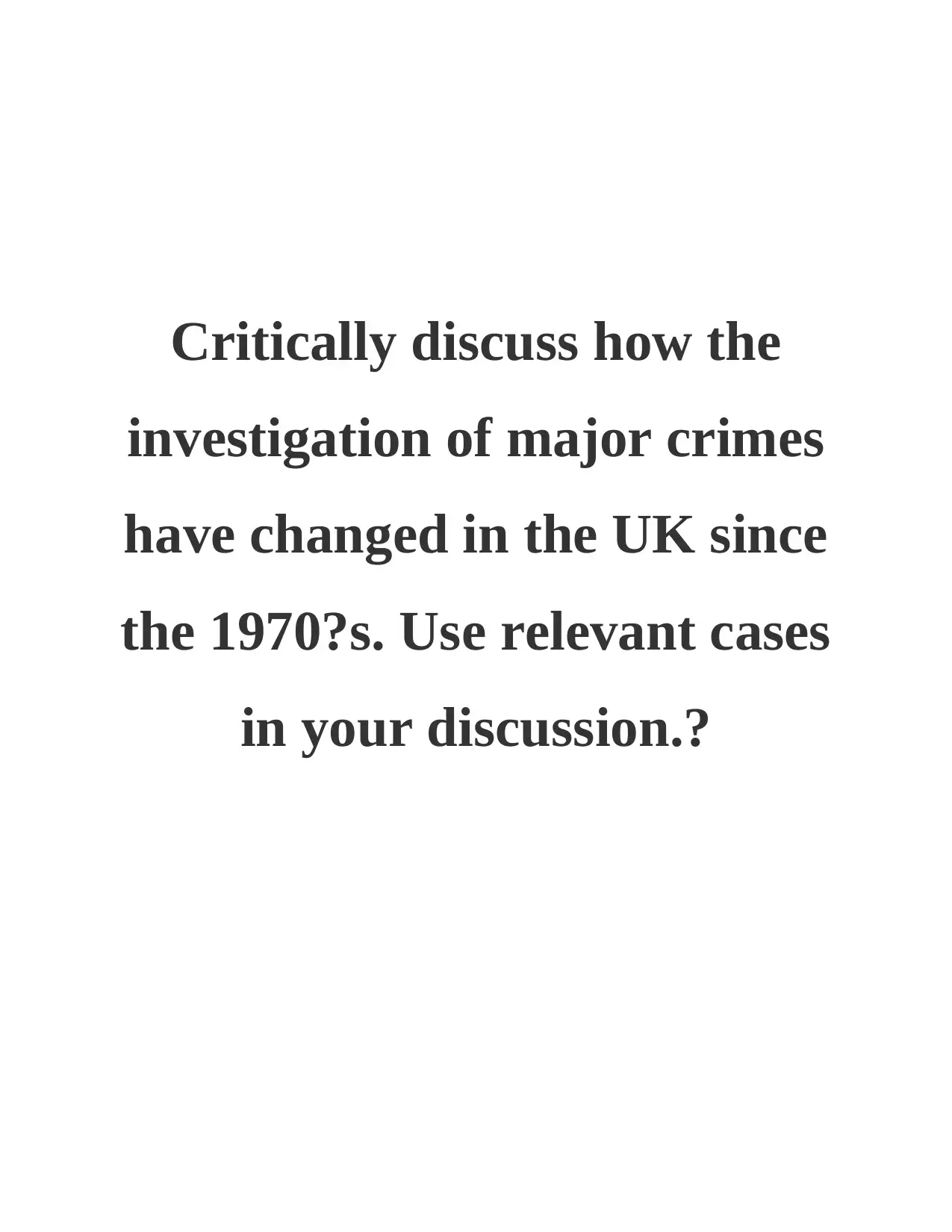
Critically discuss how the
investigation of major crimes
have changed in the UK since
the 1970?s. Use relevant cases
in your discussion.?
investigation of major crimes
have changed in the UK since
the 1970?s. Use relevant cases
in your discussion.?
Secure Best Marks with AI Grader
Need help grading? Try our AI Grader for instant feedback on your assignments.
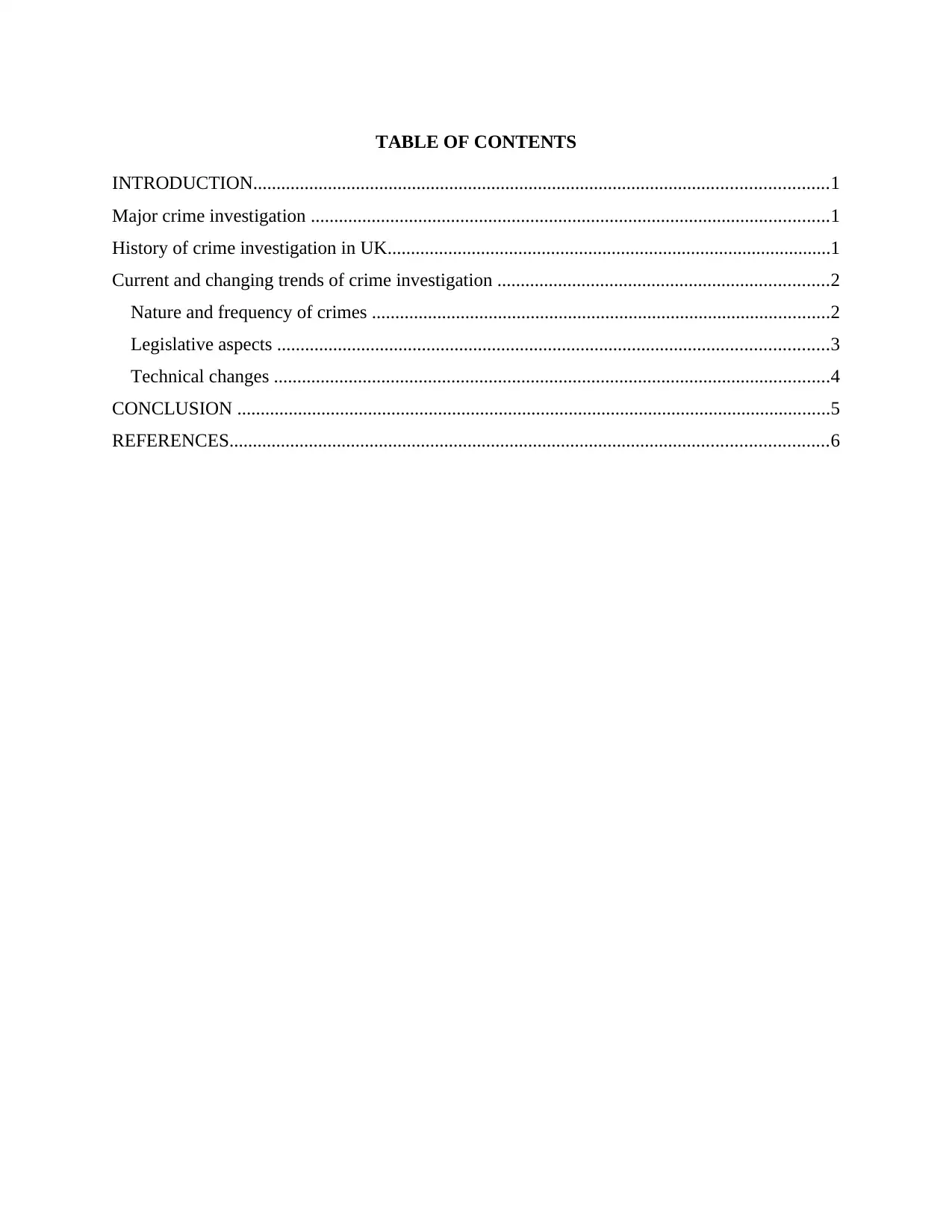
TABLE OF CONTENTS
INTRODUCTION...........................................................................................................................1
Major crime investigation ...............................................................................................................1
History of crime investigation in UK...............................................................................................1
Current and changing trends of crime investigation .......................................................................2
Nature and frequency of crimes ..................................................................................................2
Legislative aspects ......................................................................................................................3
Technical changes .......................................................................................................................4
CONCLUSION ...............................................................................................................................5
REFERENCES................................................................................................................................6
INTRODUCTION...........................................................................................................................1
Major crime investigation ...............................................................................................................1
History of crime investigation in UK...............................................................................................1
Current and changing trends of crime investigation .......................................................................2
Nature and frequency of crimes ..................................................................................................2
Legislative aspects ......................................................................................................................3
Technical changes .......................................................................................................................4
CONCLUSION ...............................................................................................................................5
REFERENCES................................................................................................................................6
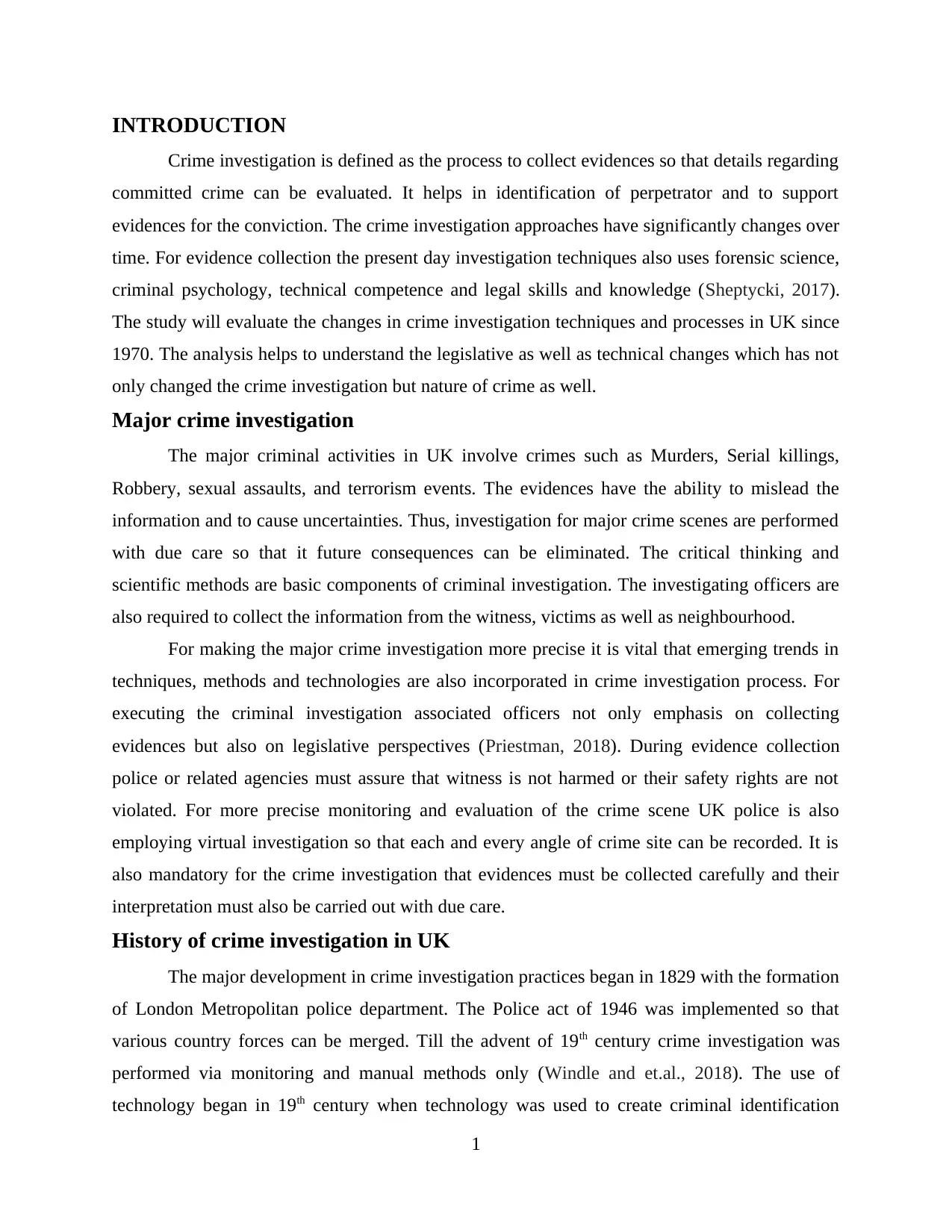
INTRODUCTION
Crime investigation is defined as the process to collect evidences so that details regarding
committed crime can be evaluated. It helps in identification of perpetrator and to support
evidences for the conviction. The crime investigation approaches have significantly changes over
time. For evidence collection the present day investigation techniques also uses forensic science,
criminal psychology, technical competence and legal skills and knowledge (Sheptycki, 2017).
The study will evaluate the changes in crime investigation techniques and processes in UK since
1970. The analysis helps to understand the legislative as well as technical changes which has not
only changed the crime investigation but nature of crime as well.
Major crime investigation
The major criminal activities in UK involve crimes such as Murders, Serial killings,
Robbery, sexual assaults, and terrorism events. The evidences have the ability to mislead the
information and to cause uncertainties. Thus, investigation for major crime scenes are performed
with due care so that it future consequences can be eliminated. The critical thinking and
scientific methods are basic components of criminal investigation. The investigating officers are
also required to collect the information from the witness, victims as well as neighbourhood.
For making the major crime investigation more precise it is vital that emerging trends in
techniques, methods and technologies are also incorporated in crime investigation process. For
executing the criminal investigation associated officers not only emphasis on collecting
evidences but also on legislative perspectives (Priestman, 2018). During evidence collection
police or related agencies must assure that witness is not harmed or their safety rights are not
violated. For more precise monitoring and evaluation of the crime scene UK police is also
employing virtual investigation so that each and every angle of crime site can be recorded. It is
also mandatory for the crime investigation that evidences must be collected carefully and their
interpretation must also be carried out with due care.
History of crime investigation in UK
The major development in crime investigation practices began in 1829 with the formation
of London Metropolitan police department. The Police act of 1946 was implemented so that
various country forces can be merged. Till the advent of 19th century crime investigation was
performed via monitoring and manual methods only (Windle and et.al., 2018). The use of
technology began in 19th century when technology was used to create criminal identification
1
Crime investigation is defined as the process to collect evidences so that details regarding
committed crime can be evaluated. It helps in identification of perpetrator and to support
evidences for the conviction. The crime investigation approaches have significantly changes over
time. For evidence collection the present day investigation techniques also uses forensic science,
criminal psychology, technical competence and legal skills and knowledge (Sheptycki, 2017).
The study will evaluate the changes in crime investigation techniques and processes in UK since
1970. The analysis helps to understand the legislative as well as technical changes which has not
only changed the crime investigation but nature of crime as well.
Major crime investigation
The major criminal activities in UK involve crimes such as Murders, Serial killings,
Robbery, sexual assaults, and terrorism events. The evidences have the ability to mislead the
information and to cause uncertainties. Thus, investigation for major crime scenes are performed
with due care so that it future consequences can be eliminated. The critical thinking and
scientific methods are basic components of criminal investigation. The investigating officers are
also required to collect the information from the witness, victims as well as neighbourhood.
For making the major crime investigation more precise it is vital that emerging trends in
techniques, methods and technologies are also incorporated in crime investigation process. For
executing the criminal investigation associated officers not only emphasis on collecting
evidences but also on legislative perspectives (Priestman, 2018). During evidence collection
police or related agencies must assure that witness is not harmed or their safety rights are not
violated. For more precise monitoring and evaluation of the crime scene UK police is also
employing virtual investigation so that each and every angle of crime site can be recorded. It is
also mandatory for the crime investigation that evidences must be collected carefully and their
interpretation must also be carried out with due care.
History of crime investigation in UK
The major development in crime investigation practices began in 1829 with the formation
of London Metropolitan police department. The Police act of 1946 was implemented so that
various country forces can be merged. Till the advent of 19th century crime investigation was
performed via monitoring and manual methods only (Windle and et.al., 2018). The use of
technology began in 19th century when technology was used to create criminal identification
1
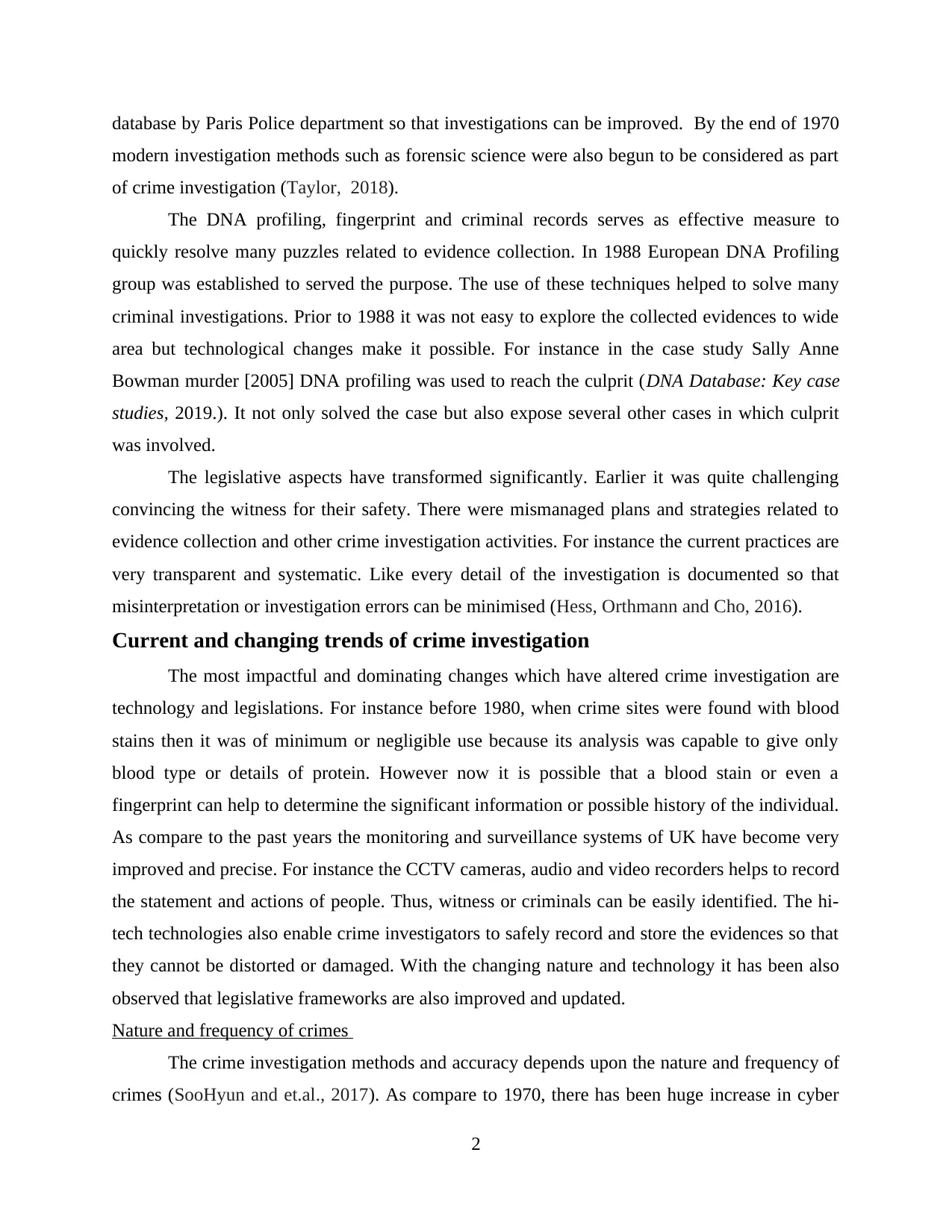
database by Paris Police department so that investigations can be improved. By the end of 1970
modern investigation methods such as forensic science were also begun to be considered as part
of crime investigation (Taylor, 2018).
The DNA profiling, fingerprint and criminal records serves as effective measure to
quickly resolve many puzzles related to evidence collection. In 1988 European DNA Profiling
group was established to served the purpose. The use of these techniques helped to solve many
criminal investigations. Prior to 1988 it was not easy to explore the collected evidences to wide
area but technological changes make it possible. For instance in the case study Sally Anne
Bowman murder [2005] DNA profiling was used to reach the culprit (DNA Database: Key case
studies, 2019.). It not only solved the case but also expose several other cases in which culprit
was involved.
The legislative aspects have transformed significantly. Earlier it was quite challenging
convincing the witness for their safety. There were mismanaged plans and strategies related to
evidence collection and other crime investigation activities. For instance the current practices are
very transparent and systematic. Like every detail of the investigation is documented so that
misinterpretation or investigation errors can be minimised (Hess, Orthmann and Cho, 2016).
Current and changing trends of crime investigation
The most impactful and dominating changes which have altered crime investigation are
technology and legislations. For instance before 1980, when crime sites were found with blood
stains then it was of minimum or negligible use because its analysis was capable to give only
blood type or details of protein. However now it is possible that a blood stain or even a
fingerprint can help to determine the significant information or possible history of the individual.
As compare to the past years the monitoring and surveillance systems of UK have become very
improved and precise. For instance the CCTV cameras, audio and video recorders helps to record
the statement and actions of people. Thus, witness or criminals can be easily identified. The hi-
tech technologies also enable crime investigators to safely record and store the evidences so that
they cannot be distorted or damaged. With the changing nature and technology it has been also
observed that legislative frameworks are also improved and updated.
Nature and frequency of crimes
The crime investigation methods and accuracy depends upon the nature and frequency of
crimes (SooHyun and et.al., 2017). As compare to 1970, there has been huge increase in cyber
2
modern investigation methods such as forensic science were also begun to be considered as part
of crime investigation (Taylor, 2018).
The DNA profiling, fingerprint and criminal records serves as effective measure to
quickly resolve many puzzles related to evidence collection. In 1988 European DNA Profiling
group was established to served the purpose. The use of these techniques helped to solve many
criminal investigations. Prior to 1988 it was not easy to explore the collected evidences to wide
area but technological changes make it possible. For instance in the case study Sally Anne
Bowman murder [2005] DNA profiling was used to reach the culprit (DNA Database: Key case
studies, 2019.). It not only solved the case but also expose several other cases in which culprit
was involved.
The legislative aspects have transformed significantly. Earlier it was quite challenging
convincing the witness for their safety. There were mismanaged plans and strategies related to
evidence collection and other crime investigation activities. For instance the current practices are
very transparent and systematic. Like every detail of the investigation is documented so that
misinterpretation or investigation errors can be minimised (Hess, Orthmann and Cho, 2016).
Current and changing trends of crime investigation
The most impactful and dominating changes which have altered crime investigation are
technology and legislations. For instance before 1980, when crime sites were found with blood
stains then it was of minimum or negligible use because its analysis was capable to give only
blood type or details of protein. However now it is possible that a blood stain or even a
fingerprint can help to determine the significant information or possible history of the individual.
As compare to the past years the monitoring and surveillance systems of UK have become very
improved and precise. For instance the CCTV cameras, audio and video recorders helps to record
the statement and actions of people. Thus, witness or criminals can be easily identified. The hi-
tech technologies also enable crime investigators to safely record and store the evidences so that
they cannot be distorted or damaged. With the changing nature and technology it has been also
observed that legislative frameworks are also improved and updated.
Nature and frequency of crimes
The crime investigation methods and accuracy depends upon the nature and frequency of
crimes (SooHyun and et.al., 2017). As compare to 1970, there has been huge increase in cyber
2
Secure Best Marks with AI Grader
Need help grading? Try our AI Grader for instant feedback on your assignments.
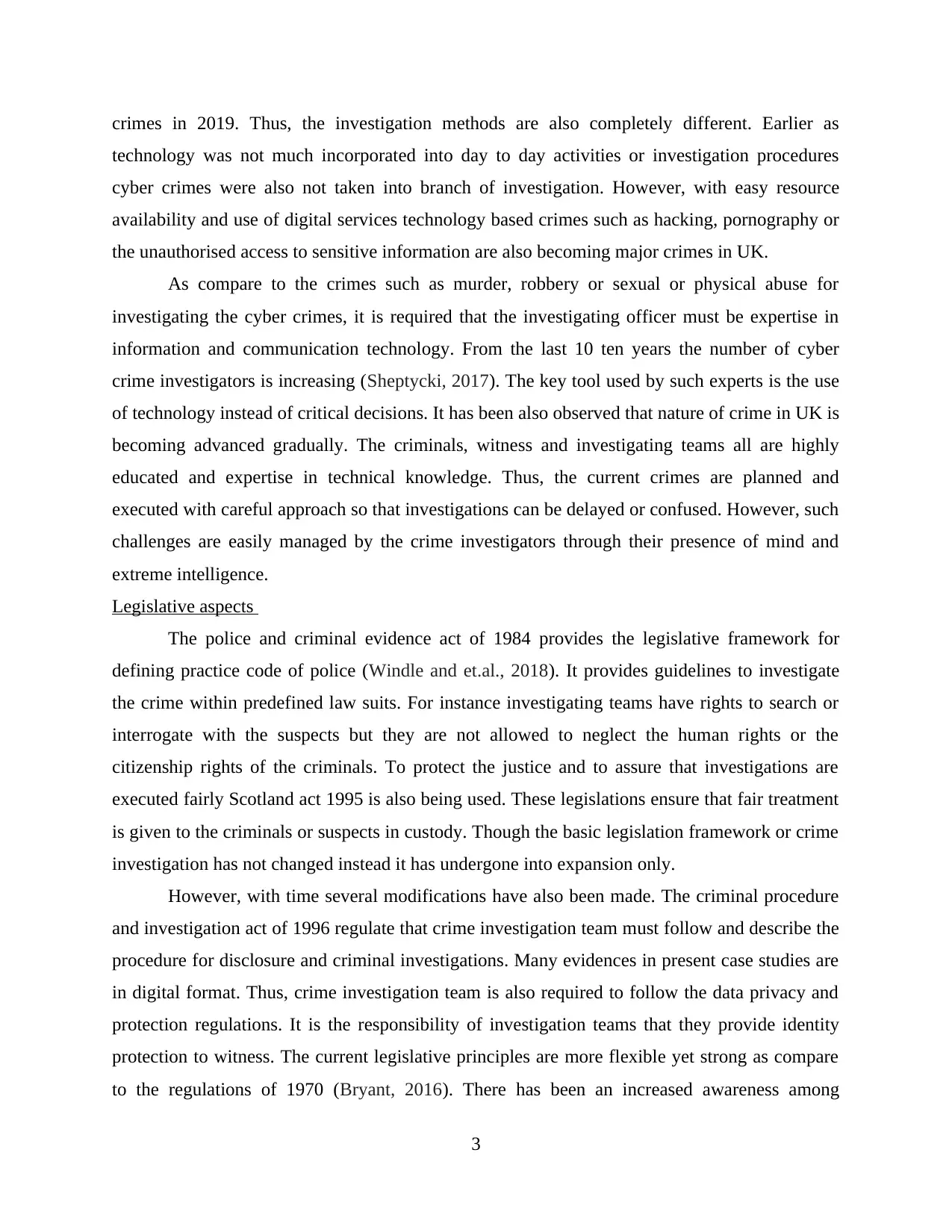
crimes in 2019. Thus, the investigation methods are also completely different. Earlier as
technology was not much incorporated into day to day activities or investigation procedures
cyber crimes were also not taken into branch of investigation. However, with easy resource
availability and use of digital services technology based crimes such as hacking, pornography or
the unauthorised access to sensitive information are also becoming major crimes in UK.
As compare to the crimes such as murder, robbery or sexual or physical abuse for
investigating the cyber crimes, it is required that the investigating officer must be expertise in
information and communication technology. From the last 10 ten years the number of cyber
crime investigators is increasing (Sheptycki, 2017). The key tool used by such experts is the use
of technology instead of critical decisions. It has been also observed that nature of crime in UK is
becoming advanced gradually. The criminals, witness and investigating teams all are highly
educated and expertise in technical knowledge. Thus, the current crimes are planned and
executed with careful approach so that investigations can be delayed or confused. However, such
challenges are easily managed by the crime investigators through their presence of mind and
extreme intelligence.
Legislative aspects
The police and criminal evidence act of 1984 provides the legislative framework for
defining practice code of police (Windle and et.al., 2018). It provides guidelines to investigate
the crime within predefined law suits. For instance investigating teams have rights to search or
interrogate with the suspects but they are not allowed to neglect the human rights or the
citizenship rights of the criminals. To protect the justice and to assure that investigations are
executed fairly Scotland act 1995 is also being used. These legislations ensure that fair treatment
is given to the criminals or suspects in custody. Though the basic legislation framework or crime
investigation has not changed instead it has undergone into expansion only.
However, with time several modifications have also been made. The criminal procedure
and investigation act of 1996 regulate that crime investigation team must follow and describe the
procedure for disclosure and criminal investigations. Many evidences in present case studies are
in digital format. Thus, crime investigation team is also required to follow the data privacy and
protection regulations. It is the responsibility of investigation teams that they provide identity
protection to witness. The current legislative principles are more flexible yet strong as compare
to the regulations of 1970 (Bryant, 2016). There has been an increased awareness among
3
technology was not much incorporated into day to day activities or investigation procedures
cyber crimes were also not taken into branch of investigation. However, with easy resource
availability and use of digital services technology based crimes such as hacking, pornography or
the unauthorised access to sensitive information are also becoming major crimes in UK.
As compare to the crimes such as murder, robbery or sexual or physical abuse for
investigating the cyber crimes, it is required that the investigating officer must be expertise in
information and communication technology. From the last 10 ten years the number of cyber
crime investigators is increasing (Sheptycki, 2017). The key tool used by such experts is the use
of technology instead of critical decisions. It has been also observed that nature of crime in UK is
becoming advanced gradually. The criminals, witness and investigating teams all are highly
educated and expertise in technical knowledge. Thus, the current crimes are planned and
executed with careful approach so that investigations can be delayed or confused. However, such
challenges are easily managed by the crime investigators through their presence of mind and
extreme intelligence.
Legislative aspects
The police and criminal evidence act of 1984 provides the legislative framework for
defining practice code of police (Windle and et.al., 2018). It provides guidelines to investigate
the crime within predefined law suits. For instance investigating teams have rights to search or
interrogate with the suspects but they are not allowed to neglect the human rights or the
citizenship rights of the criminals. To protect the justice and to assure that investigations are
executed fairly Scotland act 1995 is also being used. These legislations ensure that fair treatment
is given to the criminals or suspects in custody. Though the basic legislation framework or crime
investigation has not changed instead it has undergone into expansion only.
However, with time several modifications have also been made. The criminal procedure
and investigation act of 1996 regulate that crime investigation team must follow and describe the
procedure for disclosure and criminal investigations. Many evidences in present case studies are
in digital format. Thus, crime investigation team is also required to follow the data privacy and
protection regulations. It is the responsibility of investigation teams that they provide identity
protection to witness. The current legislative principles are more flexible yet strong as compare
to the regulations of 1970 (Bryant, 2016). There has been an increased awareness among
3
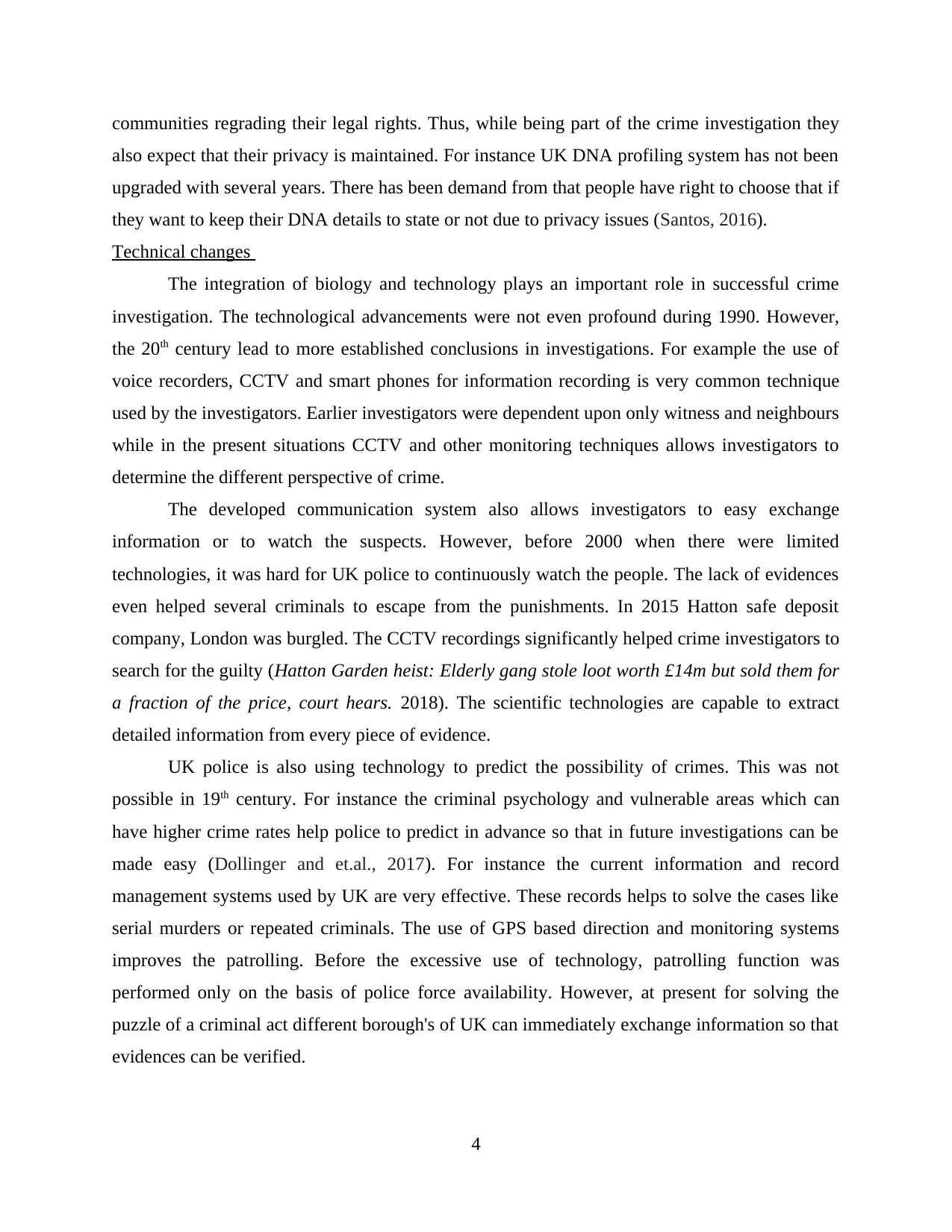
communities regrading their legal rights. Thus, while being part of the crime investigation they
also expect that their privacy is maintained. For instance UK DNA profiling system has not been
upgraded with several years. There has been demand from that people have right to choose that if
they want to keep their DNA details to state or not due to privacy issues (Santos, 2016).
Technical changes
The integration of biology and technology plays an important role in successful crime
investigation. The technological advancements were not even profound during 1990. However,
the 20th century lead to more established conclusions in investigations. For example the use of
voice recorders, CCTV and smart phones for information recording is very common technique
used by the investigators. Earlier investigators were dependent upon only witness and neighbours
while in the present situations CCTV and other monitoring techniques allows investigators to
determine the different perspective of crime.
The developed communication system also allows investigators to easy exchange
information or to watch the suspects. However, before 2000 when there were limited
technologies, it was hard for UK police to continuously watch the people. The lack of evidences
even helped several criminals to escape from the punishments. In 2015 Hatton safe deposit
company, London was burgled. The CCTV recordings significantly helped crime investigators to
search for the guilty (Hatton Garden heist: Elderly gang stole loot worth £14m but sold them for
a fraction of the price, court hears. 2018). The scientific technologies are capable to extract
detailed information from every piece of evidence.
UK police is also using technology to predict the possibility of crimes. This was not
possible in 19th century. For instance the criminal psychology and vulnerable areas which can
have higher crime rates help police to predict in advance so that in future investigations can be
made easy (Dollinger and et.al., 2017). For instance the current information and record
management systems used by UK are very effective. These records helps to solve the cases like
serial murders or repeated criminals. The use of GPS based direction and monitoring systems
improves the patrolling. Before the excessive use of technology, patrolling function was
performed only on the basis of police force availability. However, at present for solving the
puzzle of a criminal act different borough's of UK can immediately exchange information so that
evidences can be verified.
4
also expect that their privacy is maintained. For instance UK DNA profiling system has not been
upgraded with several years. There has been demand from that people have right to choose that if
they want to keep their DNA details to state or not due to privacy issues (Santos, 2016).
Technical changes
The integration of biology and technology plays an important role in successful crime
investigation. The technological advancements were not even profound during 1990. However,
the 20th century lead to more established conclusions in investigations. For example the use of
voice recorders, CCTV and smart phones for information recording is very common technique
used by the investigators. Earlier investigators were dependent upon only witness and neighbours
while in the present situations CCTV and other monitoring techniques allows investigators to
determine the different perspective of crime.
The developed communication system also allows investigators to easy exchange
information or to watch the suspects. However, before 2000 when there were limited
technologies, it was hard for UK police to continuously watch the people. The lack of evidences
even helped several criminals to escape from the punishments. In 2015 Hatton safe deposit
company, London was burgled. The CCTV recordings significantly helped crime investigators to
search for the guilty (Hatton Garden heist: Elderly gang stole loot worth £14m but sold them for
a fraction of the price, court hears. 2018). The scientific technologies are capable to extract
detailed information from every piece of evidence.
UK police is also using technology to predict the possibility of crimes. This was not
possible in 19th century. For instance the criminal psychology and vulnerable areas which can
have higher crime rates help police to predict in advance so that in future investigations can be
made easy (Dollinger and et.al., 2017). For instance the current information and record
management systems used by UK are very effective. These records helps to solve the cases like
serial murders or repeated criminals. The use of GPS based direction and monitoring systems
improves the patrolling. Before the excessive use of technology, patrolling function was
performed only on the basis of police force availability. However, at present for solving the
puzzle of a criminal act different borough's of UK can immediately exchange information so that
evidences can be verified.
4
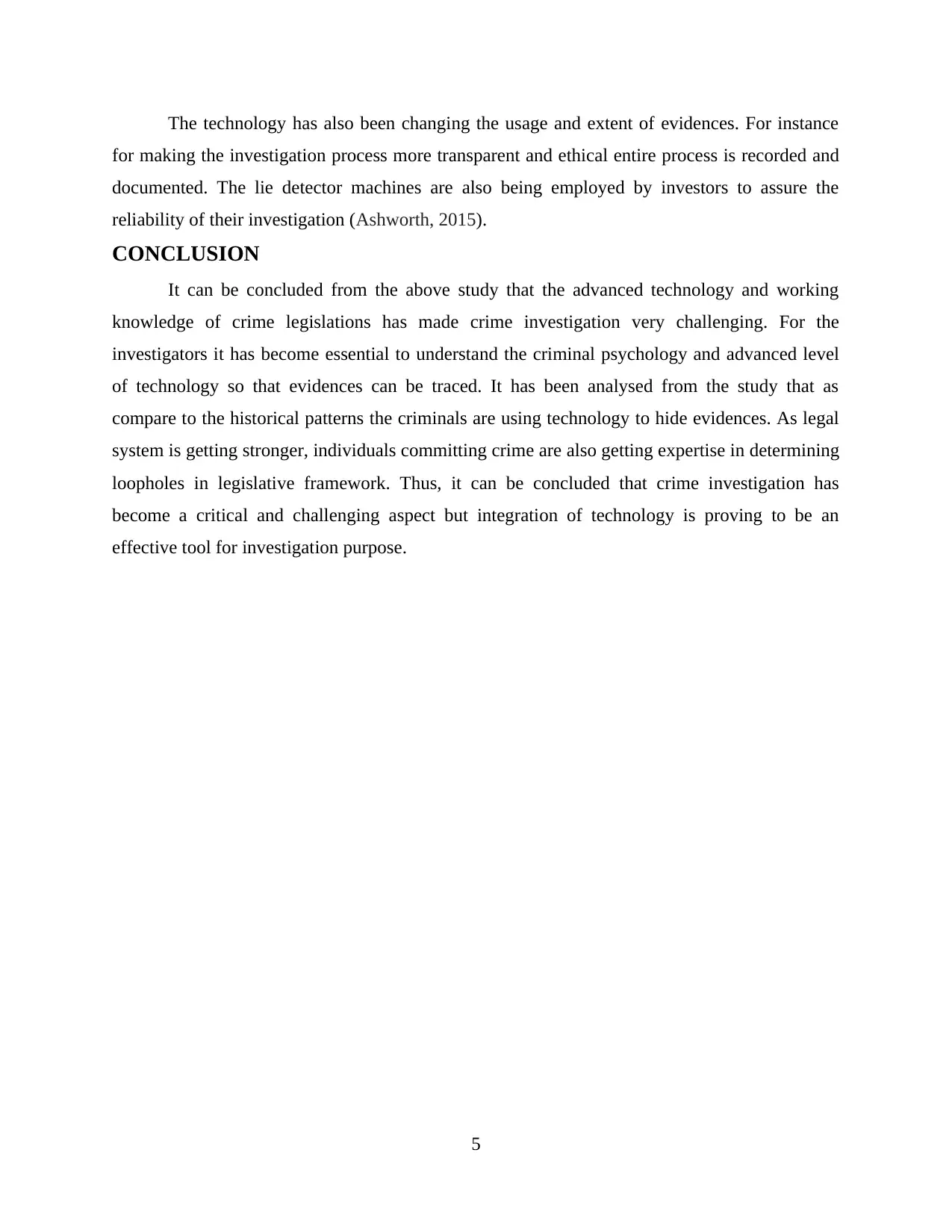
The technology has also been changing the usage and extent of evidences. For instance
for making the investigation process more transparent and ethical entire process is recorded and
documented. The lie detector machines are also being employed by investors to assure the
reliability of their investigation (Ashworth, 2015).
CONCLUSION
It can be concluded from the above study that the advanced technology and working
knowledge of crime legislations has made crime investigation very challenging. For the
investigators it has become essential to understand the criminal psychology and advanced level
of technology so that evidences can be traced. It has been analysed from the study that as
compare to the historical patterns the criminals are using technology to hide evidences. As legal
system is getting stronger, individuals committing crime are also getting expertise in determining
loopholes in legislative framework. Thus, it can be concluded that crime investigation has
become a critical and challenging aspect but integration of technology is proving to be an
effective tool for investigation purpose.
5
for making the investigation process more transparent and ethical entire process is recorded and
documented. The lie detector machines are also being employed by investors to assure the
reliability of their investigation (Ashworth, 2015).
CONCLUSION
It can be concluded from the above study that the advanced technology and working
knowledge of crime legislations has made crime investigation very challenging. For the
investigators it has become essential to understand the criminal psychology and advanced level
of technology so that evidences can be traced. It has been analysed from the study that as
compare to the historical patterns the criminals are using technology to hide evidences. As legal
system is getting stronger, individuals committing crime are also getting expertise in determining
loopholes in legislative framework. Thus, it can be concluded that crime investigation has
become a critical and challenging aspect but integration of technology is proving to be an
effective tool for investigation purpose.
5
Paraphrase This Document
Need a fresh take? Get an instant paraphrase of this document with our AI Paraphraser
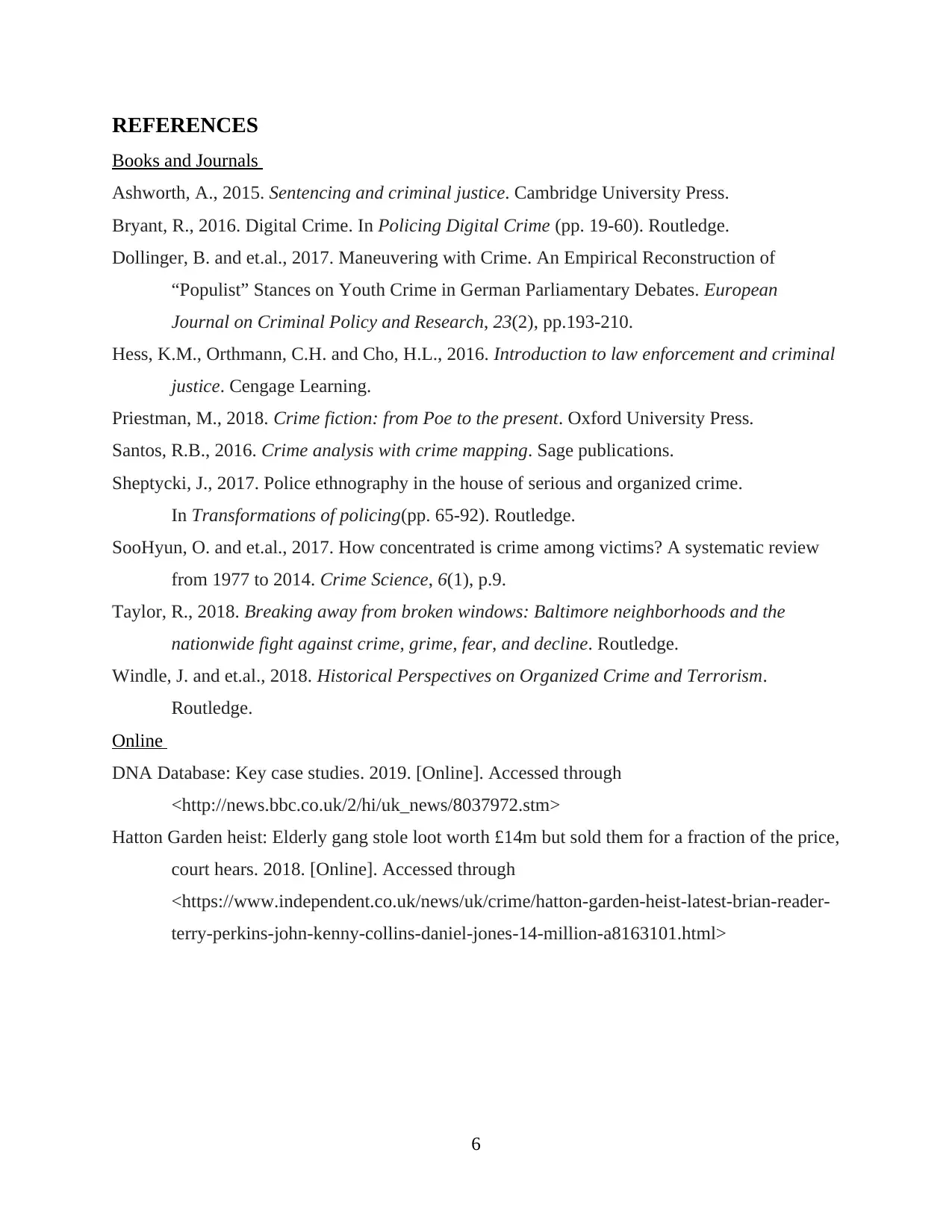
REFERENCES
Books and Journals
Ashworth, A., 2015. Sentencing and criminal justice. Cambridge University Press.
Bryant, R., 2016. Digital Crime. In Policing Digital Crime (pp. 19-60). Routledge.
Dollinger, B. and et.al., 2017. Maneuvering with Crime. An Empirical Reconstruction of
“Populist” Stances on Youth Crime in German Parliamentary Debates. European
Journal on Criminal Policy and Research, 23(2), pp.193-210.
Hess, K.M., Orthmann, C.H. and Cho, H.L., 2016. Introduction to law enforcement and criminal
justice. Cengage Learning.
Priestman, M., 2018. Crime fiction: from Poe to the present. Oxford University Press.
Santos, R.B., 2016. Crime analysis with crime mapping. Sage publications.
Sheptycki, J., 2017. Police ethnography in the house of serious and organized crime.
In Transformations of policing(pp. 65-92). Routledge.
SooHyun, O. and et.al., 2017. How concentrated is crime among victims? A systematic review
from 1977 to 2014. Crime Science, 6(1), p.9.
Taylor, R., 2018. Breaking away from broken windows: Baltimore neighborhoods and the
nationwide fight against crime, grime, fear, and decline. Routledge.
Windle, J. and et.al., 2018. Historical Perspectives on Organized Crime and Terrorism.
Routledge.
Online
DNA Database: Key case studies. 2019. [Online]. Accessed through
<http://news.bbc.co.uk/2/hi/uk_news/8037972.stm>
Hatton Garden heist: Elderly gang stole loot worth £14m but sold them for a fraction of the price,
court hears. 2018. [Online]. Accessed through
<https://www.independent.co.uk/news/uk/crime/hatton-garden-heist-latest-brian-reader-
terry-perkins-john-kenny-collins-daniel-jones-14-million-a8163101.html>
6
Books and Journals
Ashworth, A., 2015. Sentencing and criminal justice. Cambridge University Press.
Bryant, R., 2016. Digital Crime. In Policing Digital Crime (pp. 19-60). Routledge.
Dollinger, B. and et.al., 2017. Maneuvering with Crime. An Empirical Reconstruction of
“Populist” Stances on Youth Crime in German Parliamentary Debates. European
Journal on Criminal Policy and Research, 23(2), pp.193-210.
Hess, K.M., Orthmann, C.H. and Cho, H.L., 2016. Introduction to law enforcement and criminal
justice. Cengage Learning.
Priestman, M., 2018. Crime fiction: from Poe to the present. Oxford University Press.
Santos, R.B., 2016. Crime analysis with crime mapping. Sage publications.
Sheptycki, J., 2017. Police ethnography in the house of serious and organized crime.
In Transformations of policing(pp. 65-92). Routledge.
SooHyun, O. and et.al., 2017. How concentrated is crime among victims? A systematic review
from 1977 to 2014. Crime Science, 6(1), p.9.
Taylor, R., 2018. Breaking away from broken windows: Baltimore neighborhoods and the
nationwide fight against crime, grime, fear, and decline. Routledge.
Windle, J. and et.al., 2018. Historical Perspectives on Organized Crime and Terrorism.
Routledge.
Online
DNA Database: Key case studies. 2019. [Online]. Accessed through
<http://news.bbc.co.uk/2/hi/uk_news/8037972.stm>
Hatton Garden heist: Elderly gang stole loot worth £14m but sold them for a fraction of the price,
court hears. 2018. [Online]. Accessed through
<https://www.independent.co.uk/news/uk/crime/hatton-garden-heist-latest-brian-reader-
terry-perkins-john-kenny-collins-daniel-jones-14-million-a8163101.html>
6

7

8
Secure Best Marks with AI Grader
Need help grading? Try our AI Grader for instant feedback on your assignments.

9

10

11
1 out of 13
Related Documents
Your All-in-One AI-Powered Toolkit for Academic Success.
+13062052269
info@desklib.com
Available 24*7 on WhatsApp / Email
![[object Object]](/_next/static/media/star-bottom.7253800d.svg)
Unlock your academic potential
© 2024 | Zucol Services PVT LTD | All rights reserved.





